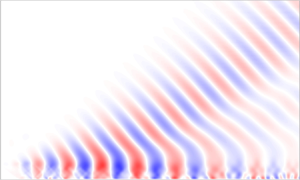Crossref Citations
This article has been cited by the following publications. This list is generated based on data provided by
Crossref.
McKeon, B. J.
2020.
A basis for flow modelling.
Journal of Fluid Mechanics,
Vol. 904,
Issue. ,
Ranjan, Rajesh
Unnikrishnan, S.
Robinet, J.-C.
and
Gaitonde, Datta
2021.
Global transition dynamics of flow in a lid-driven cubical cavity.
Theoretical and Computational Fluid Dynamics,
Vol. 35,
Issue. 3,
p.
397.
Pickering, Ethan
Rigas, Georgios
Schmidt, Oliver T.
Sipp, Denis
and
Colonius, Tim
2021.
Optimal eddy viscosity for resolvent-based models of coherent structures in turbulent jets.
Journal of Fluid Mechanics,
Vol. 917,
Issue. ,
Zhilenko, D. Yu.
and
Krivonosova, O. E.
2021.
The Effect of Broadband Rotational Velocity Fluctuations on Flows in Spherical Layers.
Technical Physics,
Vol. 66,
Issue. 12,
p.
1330.
Martini, Eduardo
Jung, Junoh
Cavalieri, André V.G.
Jordan, Peter
and
Towne, Aaron
2022.
Resolvent-based tools for optimal estimation and control via the Wiener–Hopf formalism.
Journal of Fluid Mechanics,
Vol. 937,
Issue. ,
Lugrin, Mathieu
Beneddine, Samir
Garnier, Eric
and
Bur, Reynald
2022.
Multi-scale study of the transitional shock-wave boundary layer interaction in hypersonic flow.
Theoretical and Computational Fluid Dynamics,
Vol. 36,
Issue. 2,
p.
277.
Towne, Aaron
Rigas, Georgios
Kamal, Omar
Pickering, Ethan
and
Colonius, Tim
2022.
Efficient global resolvent analysis via the one-way Navier–Stokes equations.
Journal of Fluid Mechanics,
Vol. 948,
Issue. ,
Karban, Ugur
Martini, Eduardo
Jordan, Peter
Brès, Guillaume A.
and
Towne, Aaron
2022.
Solutions to aliasing in time-resolved flow data.
Theoretical and Computational Fluid Dynamics,
Vol. 36,
Issue. 6,
p.
887.
Karban, U.
Martini, E.
Cavalieri, A.V.G.
Lesshafft, L.
and
Jordan, P.
2022.
Self-similar mechanisms in wall turbulence studied using resolvent analysis.
Journal of Fluid Mechanics,
Vol. 939,
Issue. ,
Zhilenko, D. Yu.
and
Krivonosova, O. E.
2022.
Shift of the Flow Stability Limit in the Presence of Random Rotational Velocity Fluctuations.
Technical Physics,
Vol. 67,
Issue. 5,
p.
376.
Prasad, Chitrarth
and
Gaitonde, Datta V.
2022.
A time-domain linear method for jet noise prediction and control trend analysis.
Aerospace Science and Technology,
Vol. 121,
Issue. ,
p.
107377.
Vogel, Ethan A.
and
Coder, James G.
2022.
A novel entropy normalization scheme for characterization of highly compressible flows.
Theoretical and Computational Fluid Dynamics,
Vol. 36,
Issue. 4,
p.
641.
Krivonosova, O.
Gritsevich, M.
Zhilenko, D.
and
Read, P.
2023.
Noise induced effects in the axisymmetric spherical Couette flow.
Philosophical Transactions of the Royal Society A: Mathematical, Physical and Engineering Sciences,
Vol. 381,
Issue. 2246,
Leclercq, Colin
and
Sipp, Denis
2023.
Mean resolvent operator of a statistically steady flow.
Journal of Fluid Mechanics,
Vol. 968,
Issue. ,
Cao, Shibin
Hao, Jiaao
Guo, Peixu
Wen, Chih-Yung
and
Klioutchnikov, Igor
2023.
Stability of hypersonic flow over a curved compression ramp.
Journal of Fluid Mechanics,
Vol. 957,
Issue. ,
Karban, U.
Bugeat, B.
Towne, A.
Lesshafft, L.
Agarwal, A.
and
Jordan, P.
2023.
An empirical model of noise sources in subsonic jets.
Journal of Fluid Mechanics,
Vol. 965,
Issue. ,
Gaitonde, Datta V.
and
Adler, Michael C.
2023.
Dynamics of Three-Dimensional Shock-Wave/Boundary-Layer Interactions.
Annual Review of Fluid Mechanics,
Vol. 55,
Issue. 1,
p.
291.
Martini, Eduardo
and
Schmidt, Oliver
2024.
Linstab2D: stability and resolvent analysis of compressible viscous flows in MATLAB.
Theoretical and Computational Fluid Dynamics,
Vol. 38,
Issue. 5,
p.
665.
Rolandi, Laura Victoria
Ribeiro, Jean Hélder Marques
Yeh, Chi-An
and
Taira, Kunihiko
2024.
An invitation to resolvent analysis.
Theoretical and Computational Fluid Dynamics,
Vol. 38,
Issue. 5,
p.
603.
Cheng, Cheng
Chen, Xianliang
Zhu, Wenkai
Shyy, Wei
and
Fu, Lin
2024.
Progress in physical modeling of compressible wall-bounded turbulent flows.
Acta Mechanica Sinica,
Vol. 40,
Issue. 1,


